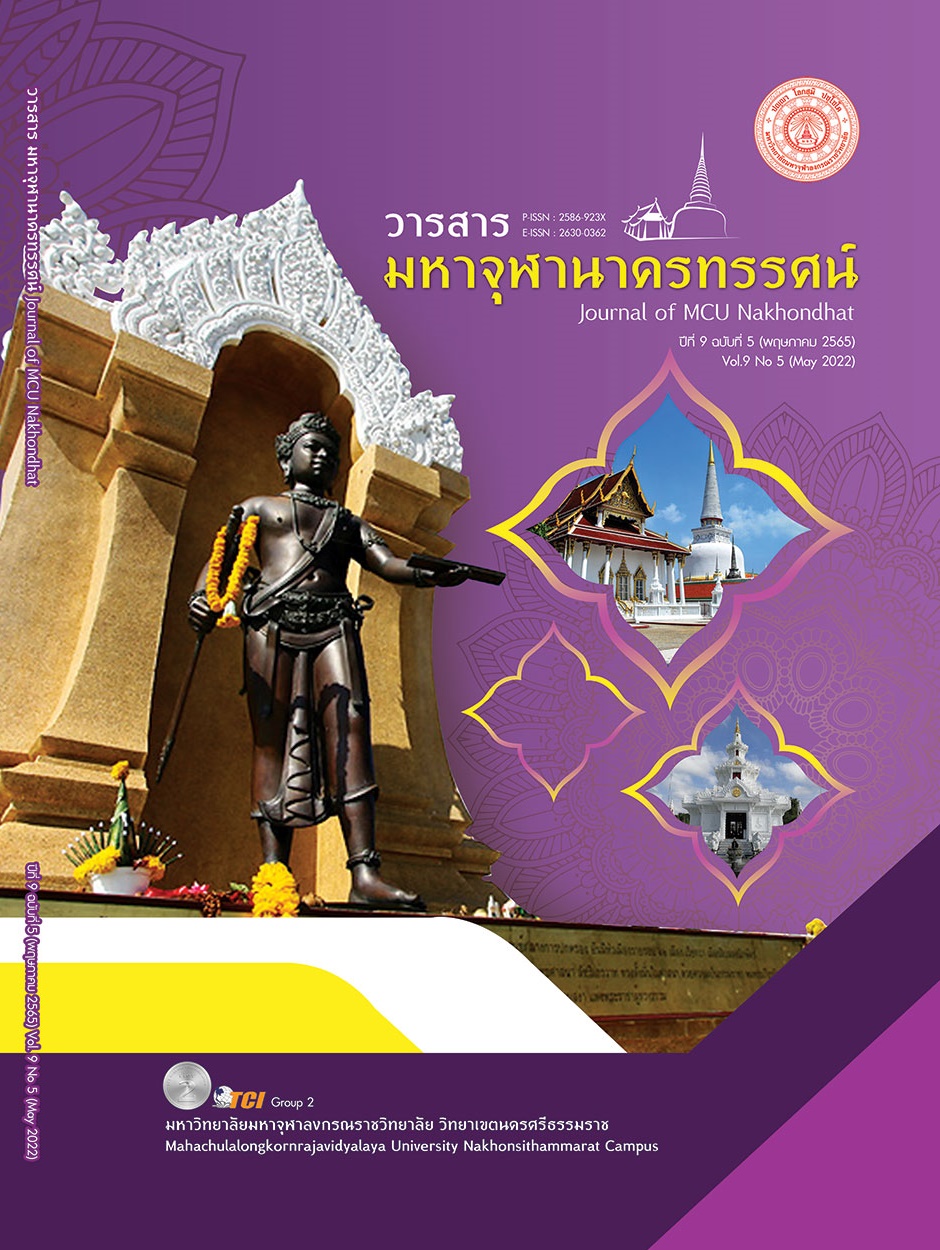THE LEARNING MANAGEMENT USING CREATIVE PROBLEM SOLVING PROCESS TOGETHER WITH THINK-PAIR-SHARE TECHNIQUE ON MATHEMATICAL CREATIVE PROBLEM SOLVING ABILITY OF SEVENTH GRADE STUDENTS FROM SRINAKHARINWIROT UNIVERSITY PRASARNMIT DEMONSTRATION SCHOOL (SECONDARY)
Main Article Content
Abstract
The purposes of this study were: 1) to compare students’ mathematical creative problem-solving abilities of seventh grade students at Srinakharinwirot University Prasarnmit Demonstration School (Secondary) before and after administrating creative problem solving process together with Think-Pair-Share technique; 2) to compare students’ mathematical creative problem-solving abilities of seventh grade students at Srinakharinwirot University Prasarnmit Demonstration School (Secondary) after administrating creative problem-solving process together with Think-Pair-Share technique with the criterion of seventy percent. The experimental method is Quasi-Experimental Research by One Group Pretest–Posttest Design. The sample of this study included 33 of seventh grade students studying in the second semester of 2020 academic year at Srinakharinwirot University Prasarnmit Demonstration School (Secondary). They were selected via cluster random sampling. The duration of the research was 20 periods. The research instruments consisted of 1) lesson plans; and 2) mathematical creative problem-solving abilities test. The data were statistically analyzed using mean, standard deviation, a t-test for dependent samples and a t-test for one sample. The findings of this study were as follows: 1) the mathematical creative problem-solving abilities of the students after experiencing creative problem-solving process together with Think-Pair-Share technique were higher than before experiencing the treatment statistically significant at a level of .01. 2) the mathematical creative problem-solving abilities of the students after experiencing creative problem-solving process together with Think-Pair-Share technique were higher than the criterion of seventy percent statistically significant at a level of .01
Article Details

This work is licensed under a Creative Commons Attribution-NonCommercial-NoDerivatives 4.0 International License.
References
เกรียงศักดิ์ เจริญวงศ์ศักดิ์. (2554). การคิดเชิงบูรณาการ. กรุงเทพมหานคร: ซัคเซส มีเดีย.
ชมนาด เชื้อสุวรรณทวี. (2561). การเรียนการสอนคณิตศาสตร์. กรุงเทพมหานคร: โรงพิมพ์แห่งจุฬาลงกรณ์มหาวิทยาลัย.
ศิริพรรณ ศรีอุทธา. (2548). การพัฒนากิจกรรมการเรียนรู้โดยใช้รูปแบบการสอนแบบร่วมมือกัน เรียนรู้เพื่อส่งเสริมทักษะการสื่อสารทางคณิตศาสตร์เรื่อง เซต สำหรับนักเรียนในช่วงชั้นที่4 (ชั้นมัธยมศึกษาปีที่4). ใน วิทยานิพนธ์ศึกษาศาสตรมหาบบัณฑิต สาขาวิชาหลักสูตรและการสอน . มหาวิทยาลัยขอนแก่น.
สถาบันทดสอบทางการศึกษาแห่งชาติ. (2562). ค่าสถิติพื้นฐาน O-NET มัธยมศึกษาปีที่ 6 ปีการศึกษา2562 (online). เรียกใช้เมื่อ 2 ธันวาคม 2563 จาก www.onetresult. niets.or.th.
สถาบันส่งเสริมการสอนวิทยาศาสตร์และเทคโนโลยี. (2551). ทักษะ/กระบวนการทางคณิตศาสตร์. กรุงเทพมหานคร: ส.เจริญการพิมพ์.
สถาบันส่งเสริมการสอนวิทยาศาสตร์และเทคโนโลยี. (2563). การแถลงข่าวผลการประเมินในโครงการ PISA 2015. เรียกใช้เมื่อ 7 ธันวาคม 2563 จาก https://pisathailand.ipst. ac.th/news-8
สมบัติ การจนารักพงค์. (2547). นวัตกรรมการศึกษา .ชุด 29 เทคนิคการจัดการกิจกรรมการเรียนรู้ที่หลากหลาย : การเรียนแบบร่วมมือเพื่อพัฒนาการเรียนรู้ผู้เรียนและการจัดทำผลงานทาง วิชาการของข้าราชการครู และบุคลากรทางการศึกษา (ครูชำนาญการ ครูชำนาญการพิเศษ ครูเชี่ยวชาญและครูเชี่ยวชาญพิเศษ ). (พิมพ์ครั้งที่1). กรุงเทพมหานคร: ธารอักษร.
สำนักงานคณะกรรมการการศึกษาขั้นพื้นฐาน กระทรวงศึกษาธิการ. (2560). ตัวชี้วัด และสาระการเรียนรู้แกนกลาง กลุ่มสาระการเรียนรู้วิทยาศาสตร์ (ฉบับปรับปรุง พ.ศ.2560). กรุงเทพมหานคร: โรงพิมพ์ชุมนุมสหกรณ์การเกษตรแห่งประเทศไทย จํากัด.
สิริพร ทิพย์คง. (2544). หนังสือเสริมประสบการณ์วิชาคณิตศาสตร์ ระดับประถมศึกษา และระดับมัธยมศึกษาตอนต้นเรื่องการแก้ปัญหาคณิตศาสตร์. กรุงเทพมหานคร: ศูนย์พัฒนาหนังสือ.
อรวรรณ ตันสุวรรณรัตน์. (2552). ผลของการจัดกิจกรรมการเรียนรู้คณิตศาสตร์ โดยใช้กระบวนการแก้ปัญหาเชิงสร้างสรรค์ ที่มีต่อความสามารถในการแก้ปัญหา และความคิดสร้างสรรค์ทางคณิตศาสตร์ ของนักเรียนมัธยมศึกษาปีที่ 2. กรุงเทพมหานคร: โรงพิมพ์แห่งจุฬาลงกรณ์มหาวิทยาลัย.
อาพันธ์ชนิต เจนจิต. (2546). กิจกรรมการเรียนการสอนเรขาคณิตโดยใช้การแก้ปัญหาอย่างสร้างสรรค์ สำหรับนักเรียนระดับประถมศึกษาตอนปลายที่มีความสามารถพิเศษทางคณิตศาสตร์. กรุงเทพมหานคร: บัณฑิตวิทยาลัยมหาวิทยาลัยศรีนครินทรวิโรฒ.
Parnes, S.J. . (1967). Creative Behavior Guidebook. New York: Charles Scribner, Son.
Torrance, E. P. (1962). Guiding Creative Talent. Englewood Cliffs, N.J: Princeton Hall.


